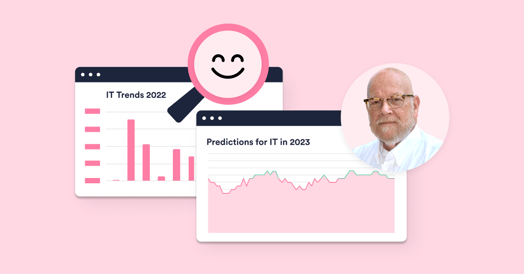CIO Agenda in 2023: Predictions from Roy Atkinson
Here we take a look at what industry authority Roy Atkinson predicts for the CIO Agenda in 2023.

In this episode of the IT Experience Podcast, we spoke with Roy Atkinson of Clifton Butterfield to find out what he predicts will be the key topics on the CIO Agenda in 2023. This blog provides a round-up of Roy's 2023 predictions for those who prefer the written word.
First, let's take a quick look at what he predicted for 2022. You can listen to the podcast of those predictions here. Roy expected that the two key areas of focus for CIOs would be:
- People - how do we better manage our people in a time of hybrid work
- Value – how do we show value to the business
Then, how do we make these things work together to benefit everyone?
As far as value is concerned, Roy was entirely on the mark. Businesses large and small, regardless of industry, wanted to know what the IT department was doing for them in 2022. They wanted to understand how they contributed to the top and bottom line. Could IT be producing things that might wind up as products? It happens in many innovative organizations; for example, IT has a useful widget that the business can use for its customers. They can sell that as a product, which results in a massive amount of value to the company.
In 2022, many organizations recognized that maybe they weren't looking at IT correctly. They no longer view the IT department as a cost center that they have to deal with when something is broken but that IT is less of a department and more of a capability. It's a different way of looking at information technology—distributed IT throughout the organization—showing us that things are changing. Digital technologies are everywhere, and we use them every day. Plus, as people have become more familiar with these technologies, the way organizations think about them has changed because people are familiar with them. They know what they're doing, and this simple fact changes things.
Now onto this year's predictions; here's what Roy has to say…
Looking ahead in 2023
If we start by looking at the results of the CIO.com 2021 survey, which surveyed IT leaders in a range of industries about where their priorities would sit in the year ahead, I was surprised to see that employee experience and/or experience management didn't make the top 10. I felt it was, or at least should have been, a CIO priority. Fast forward to the 2022 survey, and within a year, we've gone from customer experience (CX) not even making the list (although the drive to "Collaborate with business departments on major customer initiative" was included) to being the fourth priority on the CIO agenda. In it, we also see employee experience (EX) move from tenth to sixth on the list, and now it's most definitely at or near the top of every CIOs mind.
Macro Headwinds
When I sit in analyst meetings with various companies (including some pretty big ones), I hear what the financial people call macro headwinds. Macroeconomic conditions are pushing against business progress and will continue to exert pressure. We don't know how long the current economic conditions will last; these trends sometimes take months or years even to manifest themselves and can be affected by unexpected events, as we've seen in the recent pandemic, war, and weather-related disasters.
Companies may be hesitant to hire right now in many fields, and as we know, big companies like Amazon, Salesforce, and Meta (not to mention Twitter) have been doing massive amounts of reduction in force (RIF). When you've got force reduction, every role becomes more critical. Fewer people are doing the same amount of work or more work. The work has to go somewhere and goes to the workers who remain. Those people absolutely, positively have to stay productive. And if you've got to stay productive, you can't be experiencing interruptions.
This ties into some of the findings in The Global IT Benchmark: 30% of your tickets are actually contributing to 80% of the lost time, so the productivity of the affected end-users is reduced. Understanding this is critical for IT. And also, remember that when you have something like a reduction in force, your role changes, and you're picking up work from your colleagues. You may not be as familiar with their work as they were. Now you're working in applications that aren't as familiar, or you don't have the shortcuts defined the way they did. Every step becomes critical in keeping the function going. If paying attention to end-user experience was valuable before (and we know it was), it's more so now.
ESM and Digital Transformation
I think we're seeing that service management practices and tools continue to proliferate across the organization. Enterprise service management (ESM) is the usual term for that. Again, that's a convergence of business capabilities and IT capabilities. When we think about information technology, we sometimes forget that that means technology that has information at its core: the transmittal of information and creation of it, storage of it, retention of it, and protection of it. When we think of it that way, IT is distributed everywhere. We use all these digital tools in every way we can think of.
And that is, I think, part of Digital Transformation because it fundamentally changes how we do things. The transformation really is a transformation of business, the way business is done, the way work gets done, and the way processes are looked at and documented. Once you decide what changes you want to make and what outcome you wish to achieve, you look at the tools that can help you get there. And that's when digital tools come into play. We call it Digital Transformation, but it's really Transformation [comma] Digital.
First, figure out what the business problem is, and then figure out how to solve it. This is not what a lot of organizations do, by the way. A lot of organizations jump right to, "What tool can we plug in here?"
Looking at the employee experience, the end-user experience and the customer experience in detail tells you what and where the problems are. As the Global IT Benchmark report says, 13% of incidents cause 80% of productivity loss. Studying the experience says, "What is that? Let's look at that. Let's figure out what that is and solve it." Solving these problems may or may not require a tool. Often, it's carefully assessing what we're doing and how we're doing it.
I was on a call recently with a big provider of Software-as-a-Service (SaaS) that achieved 99.999% uptime for the last quarter. That's amazing, as anyone in IT knows. I asked the technology person on the call how they did it. The answer was that they carefully managed what they were looking at—where they were spending their time and effort. He answered that they concentrate on two specific areas:
- They have excellent problem management but don't manage more than six problems at a time. And if they have a seventh problem pop up, everything else stops, and that's what they work on; they solve the problems before they move on.
- Change management very carefully introduces changes to the environment.
Of course, they do the same thing with incident management: Get it solved. "If you've got a backlog that shows that you've got something sitting there and it's 60 hours old, that's the one you work on. You swarm it, solve it, and move on," he said.
In 2023, the trend of putting People at the forefront will continue, especially through experience management. The Value of IT will continue to be scrutinized, better articulated, and calculated, but it will also be understood from the perspective of an organizational capability rather than a single department.
Related content

29.09.2020
Forgetting about end-users of IT services can be costly
IT is most beneficial when users can take advantage of the opportunities offered by IT services — as efficiently and ...
Read more >
30.06.2021
How to use Real-time Experience Data in ServiceNow to understand where End-users struggle the most
There has long been a disconnect between the corporate IT department’s view of their service and support capabilities ...
Read more >
